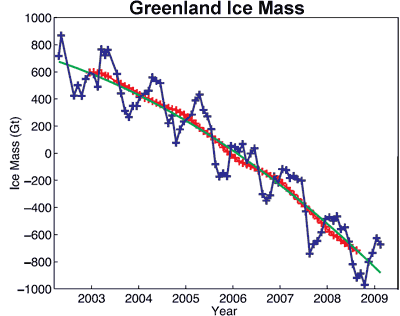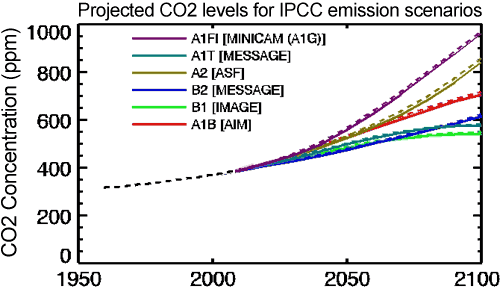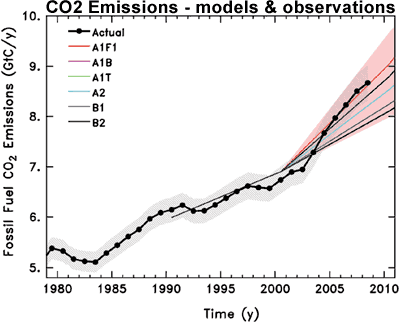What CO2 level would cause the Greenland ice sheet to collapse?
Posted on 23 March 2010 by John Cook
A matter of concern is the potential instability of the Greenland and Antarctic ice sheets. If the Greenland ice sheet was to completely collapse, it would contribute as much as 7 metres sea level rise. Similarly, the West Antarctic ice sheet would contribute around 6 metres sea level rise. East Antarctica would contribute 70 metres of sea level rise but is less prone to collapse. Consequently, how these ice sheets respond to warming temperatures is a crucial area of research. A new paper () has been published that estimates that the CO2 level that will lead to collapse of the Greenland ice sheet is between 400 to 560 parts per million (ppm). At our current rate, we should pass 400 ppm within 10 years.
While there are uncertainties over the specifics of ice sheet behaviour, there are several lines of independent evidence that paint a consistent picture of how ice sheets will respond to global warming. Focusing on Greenland, what do observations tell us has been happening to the Greenland ice sheet? Satellites use gravity data to measure the total mass balance and have found the ice sheet is losing ice mass at an accelerating rate (Velicogna 2009).

Figure 1: Ice mass changes for the Greenland ice sheet estimated from GRACE satellite measurements. Unfiltered data are blue crosses. Data filtered for the seasonal dependence are shown as red crosses. The best-fitting quadratic trend is shown as a green line (Velicogna 2009).
How can we know how the Greenland ice sheet will behave over a longer time period? We can determine this by looking at how the ice sheet has responded in the past. Some of the more optimistic emission scenarios from the IPCC predict warming of 1 to 2°C. The last time temperatures were this high were 125,000 years ago. At this time, sea levels were over 6 metres higher than current levels (Kopp 2009). This tells us that the Greenland and Antarctic ice sheets are highly sensitive to sustained, warmer temperatures and that in upcoming centuries, we can expect sea level rise in the range of metres, not centimetres.
Further light is shed on Greenland ice sheet stability in a new paper The effect of more realistic forcings and boundary conditions on the modelled geometry and sensitivity of the Greenland ice-sheet
Although not completely collapsed, the 400 ppm ice-sheet loses ice mass in the north of the island, with a total reduction in ice volume ranging between 20 to 41%. Note - due to the large inertia of the Greenland ice sheet, this mass loss doesn't happen at the moment CO2 levels reach 400 ppm but over a period of centuries. Under a 560 ppm climate, the Greenland ice sheet loses between 52 to 87% of its ice volume. If CO2 reaches 1120 ppm, there is almost complete elimination of the Greenland ice sheet with loss between 85 to 92%. The important result from this paper is that there is a critical threshold where the Greenland ice sheet becomes unstable somewhere between 400 and 560 ppm.
This is a large uncertainty range and one imagines there will be much research in the next few years to reduce the uncertainty. However, the 400 to 560 ppm range is put into perspective when you look at the projected CO2 levels for the various IPCC scenarios. The business as usual scenario has CO2 levels reaching 1000 ppm by 2100. Even the most optimistic scenario tops 500 ppm by 2100.

Figure 3: Atmospheric CO2 concentrations as observed at Mauna Loa from 1958 to 2008 (black dashed line) and projected under the 6 IPCC emission scenarios (solid coloured lines). (IPCC Data Distribution Centre)
Of course, Figure 3 displays projected scenarios. What has been happening in the real world? Observed CO2 emissions in recent years have actually been tracking close to or above the worst case scenario.

Figure 4: Observed global CO2 emissions from fossil fuel burning and cement production compared with IPCC emissions scenarios. The coloured area covers all scenarios used to project climate change by the IPCC (Copenhagen Diagnosis).
Satellite measurements, paleoclimate data and ice sheet modelling all paint a consistent picture. Global warming is destabilising the Greenland ice sheet which is highly sensitive to sustained warmer temperatures. Our current trajectory with CO2 emissions will likely cause at least several metres sea level rise from the Greenland ice sheet over the next few centuries. Of course, we shouldn't forget that this estimate doesn't include Antarctica - the Antarctic ice sheet is also losing ice at an accelerating rate.































 Arguments
Arguments
































I wouldn't characterise it as a sudden, violent process. I'd characterise it more like pushing a huge, heavy boulder from the top of a hill. It's difficult at first and moves slowly. But then you reach a tipping point where it's momentum starts to carry it down the hill and then there's no stopping it.
Yes, Greenland ice mass change has been determined by other methods (van den Broeke et al 2009). This paper is explored in an earlier post Why is Greenland's ice loss accelerating?
Figure 1: Monthly carbon dioxide concentration (blue thin line) and its long term trend (strong blue line) as measured at Mauna Loa, Hawaii. Dashed line is IPCC's projected carbon dioxide levels (Rahmstoorf 2007).
The more serious impact from disappearing glaciers is the eventual loss of a source of seasonal drinking water for hundreds of millions of people.
Just an amusing anecdote. More seriously, noone is wishing for glaciers to grow and take over the regions that we inhabit. There is no danger of that happening. But what is of serious concern is that the glaciers that seasonally melt and provide summer drinking water are retreating at an accelerating rate. This threatens the water supplies of hundreds of millions of people. Well, hundreds of millions of people now. By the time the glaciers have disappeared, I imagine it will be significantly more people that are affected.
Figure 1 is the change in total mass of the Greenland ice sheet. This is measured by satellites which measure the change in the gravity field around Greenland (Velicogna 2009).
"you don't compare with any estimates of how that figure would look like if we did not add any extra CO2 into the atmosphere"
If we hadn't added any extra CO2 into the atmosphere, we would have experienced a slight, long-term cooling trend over the last half century (Meehl 2004). It's difficult to see how Greenland could lose ice mass at an accelerating rate if global temperatures were cooling.
"Do you have any example or good explanation to this claim making it plausible?"
A good example of the high sensitivity of ice sheets to warmer temperatures is the behaviour of ice sheets 125,000 years ago. At this time, temperatures were 1 to 2°C warmer than current conditions. Sea levels were at least 6.6 metres higher than current values. This is strong evidence that ice sheets are sensitive to sustained warmer temperatures (Kopp 2009).
How does it happen? The Greenland and West Antarctic ice sheets sit on bedrock that is underwater. As the oceans warm, they melt the ice sheets from below - this causes the ice sheets to slide faster into the ocean (van den Broeke et al 2009). This is what is being observed now by satellites.
It's not fantasy, it's not alarmism, it's peer-reviewed science based on multiple lines of empirical observations.
I'm now waiting for a new skeptic argument: "global warming was caused by the Pope".